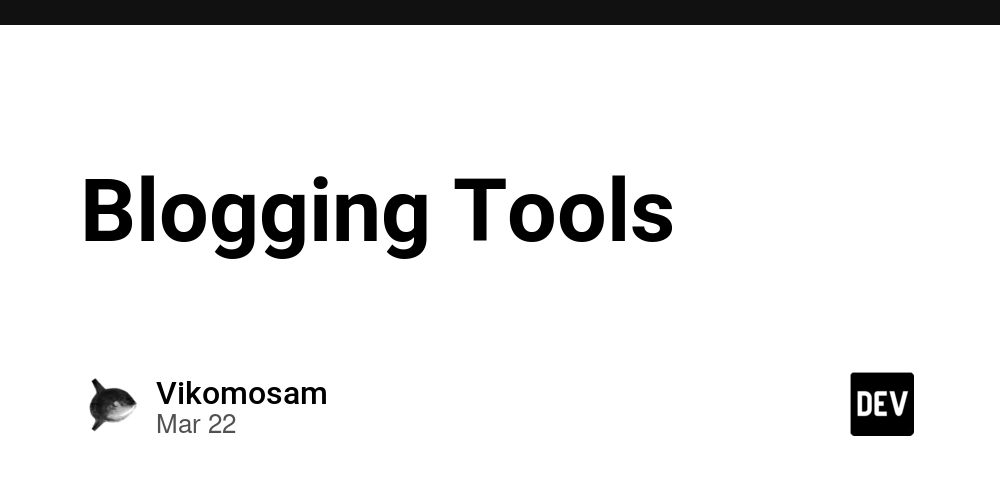Blogging Tools
Here are several free alternatives to Substack for blogging, along with details on their features, strengths, and ideal use cases: Medium Overview: A widely used platform that emphasizes writing and storytelling. Features: Built-in Audience: Your posts can be discovered by Medium’s large readership. Easy to Use: A clean editor and minimal setup let you focus on writing. Monetization: You can join the Medium Partner Program for revenue if your work is popular. Considerations: Customization and branding options are limited. You don’t have full ownership of your audience as it’s hosted on Medium’s ecosystem. WordPress.com Overview: A powerful blogging platform offering both free and paid plans. Features: Customization: Numerous themes and plugins (even on the free plan) help you tailor your site. Scalability: Ideal if you later want to expand features or migrate to a self-hosted WordPress.org site. SEO & Integration: Good for SEO and integrates with many third‑party tools. Considerations: While the free plan is robust, some advanced features require upgrading. You may need to add an external newsletter service if you want integrated email campaigns. Hashnode Overview: A free blogging platform tailored for developers and tech writers. Features: Custom Domain: You can use a custom domain for free, enhancing your professional image. Community Focus: Built-in communities and technical discussions help drive engagement. SEO-Friendly: Posts are optimized for search engines, which can boost discoverability. Considerations: Best suited for tech topics; if your content extends beyond tech, the community vibe may be less aligned. Dev.to Overview: A community-driven platform specifically for developers, though it’s open to a range of tech topics. Features: Engaged Community: Readers and other developers actively interact via comments and reactions. Easy Publishing: A simple interface gets your ideas published quickly. Free & Open: No fees, and you benefit from the platform’s strong community network. Considerations: As a niche community, the audience is tech-focused, which is perfect if your blog is centered on development or tech insights. Write.as Overview: A minimalistic blogging platform that prioritizes simplicity and distraction-free writing. Features: Simplicity: A clean interface ideal for writers who want to focus solely on content. Privacy: Emphasizes anonymity and privacy, if that’s important to you. Flexibility: It supports basic customization and can be used to publish posts quickly. Considerations: Fewer community features compared to Medium or Hashnode. Limited in advanced design options unless you upgrade to a paid version. Choosing the Right Platform If you want a built‑in audience and a focus on storytelling: Medium is a great option, though it limits your customization and control. If you need more design freedom and long‑term growth potential: WordPress.com offers flexibility and scalability, even on the free tier. If your focus is on tech content and community engagement: Hashnode and Dev.to provide vibrant, tech‑oriented communities with added benefits like custom domains (in Hashnode’s case). If you prefer a minimalist writing environment: Write.as is ideal for distraction‑free writing, though it’s less focused on community building. Each option is free to start with, so you might try one or two platforms to see which best aligns with your goals as a tech blogger without any initial investment. This comparison should help you decide based on factors like community, ease of use, design flexibility, and monetization potential. If you need further details on any platform or more specific comparisons, let me know!

Here are several free alternatives to Substack for blogging, along with details on their features, strengths, and ideal use cases:
- Medium Overview: A widely used platform that emphasizes writing and storytelling.
Features:
Built-in Audience: Your posts can be discovered by Medium’s large readership.
Easy to Use: A clean editor and minimal setup let you focus on writing.
Monetization: You can join the Medium Partner Program for revenue if your work is popular.
Considerations:
Customization and branding options are limited.
You don’t have full ownership of your audience as it’s hosted on Medium’s ecosystem.
- WordPress.com Overview: A powerful blogging platform offering both free and paid plans.
Features:
Customization: Numerous themes and plugins (even on the free plan) help you tailor your site.
Scalability: Ideal if you later want to expand features or migrate to a self-hosted WordPress.org site.
SEO & Integration: Good for SEO and integrates with many third‑party tools.
Considerations:
While the free plan is robust, some advanced features require upgrading.
You may need to add an external newsletter service if you want integrated email campaigns.
- Hashnode Overview: A free blogging platform tailored for developers and tech writers.
Features:
Custom Domain: You can use a custom domain for free, enhancing your professional image.
Community Focus: Built-in communities and technical discussions help drive engagement.
SEO-Friendly: Posts are optimized for search engines, which can boost discoverability.
Considerations:
Best suited for tech topics; if your content extends beyond tech, the community vibe may be less aligned.
- Dev.to Overview: A community-driven platform specifically for developers, though it’s open to a range of tech topics.
Features:
Engaged Community: Readers and other developers actively interact via comments and reactions.
Easy Publishing: A simple interface gets your ideas published quickly.
Free & Open: No fees, and you benefit from the platform’s strong community network.
Considerations:
As a niche community, the audience is tech-focused, which is perfect if your blog is centered on development or tech insights.
- Write.as Overview: A minimalistic blogging platform that prioritizes simplicity and distraction-free writing.
Features:
Simplicity: A clean interface ideal for writers who want to focus solely on content.
Privacy: Emphasizes anonymity and privacy, if that’s important to you.
Flexibility: It supports basic customization and can be used to publish posts quickly.
Considerations:
Fewer community features compared to Medium or Hashnode.
Limited in advanced design options unless you upgrade to a paid version.
Choosing the Right Platform
If you want a built‑in audience and a focus on storytelling:
Medium is a great option, though it limits your customization and control.
If you need more design freedom and long‑term growth potential:
WordPress.com offers flexibility and scalability, even on the free tier.
If your focus is on tech content and community engagement:
Hashnode and Dev.to provide vibrant, tech‑oriented communities with added benefits like custom domains (in Hashnode’s case).
If you prefer a minimalist writing environment:
Write.as is ideal for distraction‑free writing, though it’s less focused on community building.
Each option is free to start with, so you might try one or two platforms to see which best aligns with your goals as a tech blogger without any initial investment.
This comparison should help you decide based on factors like community, ease of use, design flexibility, and monetization potential. If you need further details on any platform or more specific comparisons, let me know!










































































































































































![[The AI Show Episode 142]: ChatGPT’s New Image Generator, Studio Ghibli Craze and Backlash, Gemini 2.5, OpenAI Academy, 4o Updates, Vibe Marketing & xAI Acquires X](https://www.marketingaiinstitute.com/hubfs/ep%20142%20cover.png)



























































































































![[FREE EBOOKS] The Kubernetes Bible, The Ultimate Linux Shell Scripting Guide & Four More Best Selling Titles](https://www.javacodegeeks.com/wp-content/uploads/2012/12/jcg-logo.jpg)



![From drop-out to software architect with Jason Lengstorf [Podcast #167]](https://cdn.hashnode.com/res/hashnode/image/upload/v1743796461357/f3d19cd7-e6f5-4d7c-8bfc-eb974bc8da68.png?#)






































































































.png?#)




.jpg?#)
































_Christophe_Coat_Alamy.jpg?#)







































































































![Rapidus in Talks With Apple as It Accelerates Toward 2nm Chip Production [Report]](https://www.iclarified.com/images/news/96937/96937/96937-640.jpg)









































































































































